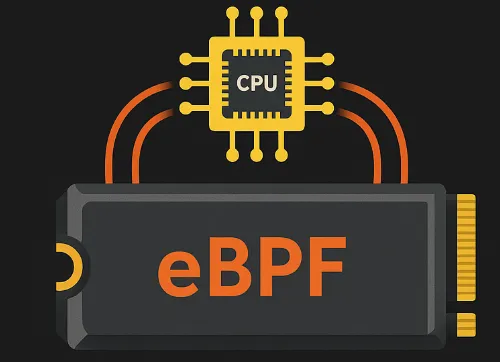Redefining Data Processing with eBPF in NVMe SSDs¶
Author: Khushi Chhillar
Published: June 15, 2025
Introduction¶

Computational storage represents a paradigm shift where storage devices participate in data processing operations rather than serving solely as passive storage repositories. This approach implements real-time filtering, searching, and computational tasks directly within the storage controller, eliminating data movement overhead and improving system efficiency.
eBPF offloading to computational storage devices enables sophisticated data processing capabilities at the storage layer, fundamentally transforming traditional storage architecture models.
Traditional Storage Architecture Limitations¶
Contemporary storage systems require full data retrieval for processing operations. For example, when performing file metadata searches, traditional systems must:
Read all target files from the storage device
Transfer data to system memory (RAM)
Process data using main processor resources
Return processed results to the application
This approach creates significant performance bottlenecks due to data movement overhead, memory bandwidth consumption, and processor resource utilization for basic filtering operations.
Computational Storage Architecture¶
Computational storage implements data processing capabilities directly within storage controllers. Rather than transferring all data to system memory, the storage device performs filtering and processing operations internally, returning only relevant results to the requesting application.
This architecture model eliminates unnecessary data movement while providing significant improvements in system performance and energy efficiency.
eBPF Integration with Storage Controllers¶
eBPF (Extended Berkeley Packet Filter) provides a lightweight, secure, and efficient programming framework executable within hardware components such as storage devices.
eBPF programs offer the following capabilities:
Execute specific computational tasks including data filtering and analysis
Operate within sandboxed environments ensuring system stability
Support dynamic updates and reconfiguration for new processing requirements
eBPF-Enabled NVMe Storage Implementation¶
Recent research developments have successfully demonstrated eBPF program execution within NVMe SSD controllers, enabling computational capabilities at the storage device level.
This implementation provides the following operational capabilities:
Data preprocessing prior to CPU processing
Source-level data filtering operations
Basic analytical functions including counting, sorting, and metadata tagging
Reduced latency, memory utilization, and power consumption
Case Study: Photo Search Optimization¶
Traditional Approach:
Complete dataset transfer of 10,000 photos to system memory
Sequential CPU-based filtering operations
High latency and energy consumption
eBPF-Enhanced Approach:
eBPF execution within SSD controller
Device-level filtering by temporal metadata
Selective data transfer of relevant results (e.g., 50 photos from 2023)
This approach demonstrates significant improvements in processing speed, resource utilization, and system efficiency.
Application Domains and Use Cases¶
Media Streaming Services
Real-time video transcoding within storage devices
Optimized content buffering mechanisms
Real-time user behavior analytics
Mobile Computing
Automated media organization using facial recognition algorithms
Intelligent cloud backup optimization
Power-efficient computational offloading
E-commerce Platforms
Accelerated product search capabilities
Real-time review processing and filtering
Enhanced data update mechanisms
Delilah Project¶
Researchers at the IT University of Copenhagen developed the first functional prototype of eBPF computational storage, designated as the Delilah system. This implementation demonstrates the practical viability of secure eBPF execution within NVMe SSD controllers.
The Delilah project provides empirical validation of eBPF computational storage concepts through working prototype demonstration.
Technology Adoption Timeline¶
Near-term (2-3 years)
Computational storage deployment in enterprise data centers
Development frameworks for storage-aware eBPF programming
Medium-term (3-7 years)
Consumer device integration in laptops and mobile platforms
Performance optimization for streaming and file management applications
Long-term (7-10 years)
Industry-wide standardization of computational storage
Expansion to IoT and edge computing devices
Technical Benefits and Impact¶
Reduced latency for file access and search operations
Improved energy efficiency through minimized data transfer requirements
Enhanced application performance through intelligent computational offloading
Implementation Challenges¶
Paradigm shift requiring storage-aware programming methodologies
Initial cost premium for early computational storage devices
Industry standardization requirements for interoperability across vendors
Industry Development Initiatives¶
Major technology companies and emerging startups are actively developing computational storage solutions for:
Enterprise data centers for cloud infrastructure optimization
Personal computing devices for enhanced user experience
Mobile and edge computing platforms for AI processing and power efficiency
Conclusion: Computational Storage Paradigm¶
Computational storage represents a fundamental shift from passive storage architectures to intelligent, processing-capable storage systems. This evolution enables:
Active data filtering and processing capabilities
Autonomous computational decision-making
Optimized system performance and energy efficiency
The transition from traditional data retrieval models to intelligent data processing demonstrates the evolution from:
Complete dataset transfer for external processing
Selective, preprocessed data delivery based on computational requirements
Future Considerations¶
The computational storage paradigm represents a significant advancement in data processing architecture, transitioning from passive storage repositories to intelligent computational platforms capable of autonomous data processing and filtering operations.
This technology evolution indicates a broader shift toward distributed intelligence within computing infrastructure components.